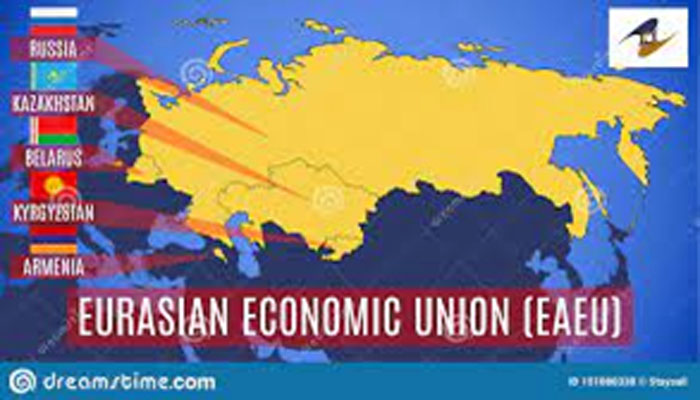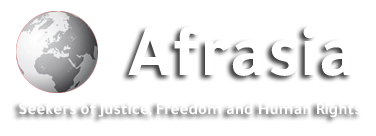
Afrasianet - The term (EAEU) Eurasian Economic Union is often repeated in the media and economic research centers, so what is it? It is an international economic union and a free trade area comprising countries located in Central and Northern Asia and Eastern Europe .
The founding member states of Belarus, Kazakhstan and Russia created the union by treaty in 2014 and formally implemented the agreement starting on January 1, 2015. It is estimated that nearly 200 million people live within member states and that EAEU countries have $5 trillion in combined GDP. The Eurasian Economic Union (EAEU) is a free trade agreement that came into force in 2015 to increase economic cooperation and raise the standard of living for its members.
• Member states include Russia, Armenia, Belarus, Kazakhstan and Kyrgyzstan.
• Unlike the European Union (EU), the EAEU does not share a common currency. Understanding the Eurasian Economic
Union The Eurasian Economic Union was created in part in response to the economic and political influence of the European Union (EU) and other Western trade agreements. EAEU member countries include Armenia, Belarus, Kazakhstan, Kyrgyzstan and Russia. The main objectives of the organization are to increase cooperation and economic competitiveness of the member states, and to promote stable development in order to raise the standard of living in the member states.
The EAEU guarantees the free movement of goods, services, labor, and capital between states, and provides for common policies in the field of macroeconomics, transportation, industry and agriculture, energy, foreign trade and investment, customs, technical regulation, competition, and antitrust regulation. .
Unlike the treaty that formed the eurozone, the treaty that formed the Eurasian Economic Union did not establish a single currency yet. The EAEU heads of state consist of a governing body known as the Eurasian Supreme Economic Council, and the executive body that oversees day-to-day operations known as the Eurasian Economic Commission, which is a counterpart to the European Commission.
The EAEU Court acts as a judicial body. History of EAEU After the dissolution of the Soviet Union in 1991, the economies of the former Soviet republics were in shambles due to decades of mismanagement, and many Eurasia republics experienced sudden economic turmoil as they adapted to the post-Soviet era.
The political collapse of the Soviet Union also led to the severing of many fruitful economic relations between these countries. However, the end of the Soviet Union as a political entity does not mean that historical relations between Russia and countries known as the "near abroad" have evaporated nor that they are still unable to reap the gains of comparative advantage, trade or the benefits of economic integration. New forms of economic cooperation are needed. To this end, talks began between the countries of the region on economic cooperation.
In March 1994, Kazakh President Nursultan Nazarbayev first proposed the idea of creating a business alliance during a speech at Moscow State University. By June 1994, a detailed plan for the Eurasian Union had been drafted and presented to the heads of state. Belarus, Kazakhstan and Russia signed the Customs Union Treaty in 1995, which laid the foundation for economic cooperation among the member states.
Then, over the following decades, a series of additional treaties strengthened economic relations between the Eurasian states, all of which were members of the former Soviet Union. In December 2010, the Declaration on the Creation of the Single Economic Space of the Republic of Belarus, the Republic of Kazakhstan and the Russian Federation was signed, laying the foundation for the Eurasian Economic Union.
This treaty, which came into force in 2012, guaranteed the free movement of goods, services, labor and capital between countries. On May 29, 2014, the EAEU was formally established when the founding member states of Belarus, Kazakhstan and Russia signed the Eurasian Economic Union Treaty and this treaty entered into force on January 1, 2015. Armenia and Kyrgyzstan signed accession agreements to the EAEU in October 2014 and December 2014 respectively. On January 2, 2015, the Eurasian Economic Union Treaty entered into force for Armenia, and on August 6, 2015, it entered into force for Kyrgyzstan.
The future of the Eurasian Economic Union Russian President Vladimir Putin has indicated that his ultimate goal is to expand the Eurasian Economic Union to include all post-Soviet states.
This will necessarily exclude the three Baltic states (Lithuania, Latvia and Estonia) that have already joined the EU instead. Membership has been granted to Tajikistan, Uzbekistan, Georgia, Moldova, Ukraine and Turkey. However, Georgia, Moldova, Ukraine and Turkey have been offered EU membership.
The pro-Russian breakaway regions of Georgia, Moldova, and Ukraine have taken steps toward integration with the Eurasian Economic Union.
These two economic unions are, in fact, contesting the economic integration of Eastern Europe. Eurasian Economic Commission The Eurasian Economic Commission (EEC) is the permanent regulatory body of the Eurasian Economic Union (EAEU). Work began on February 2, 2012.
The main purpose of the Eurasian Economic Commission is to ensure the functioning and development of the Eurasian Economic Union, to develop proposals for the further development of integration.
The EEC has the status of a supranational regulatory body and its activity is guided by the interests of the countries participating in the Eurasian economic integration project in general, and its decisions are not motivated by any interests of national governments.
The decisions of the Commission are mandatory for implementation on the territory of the member states of the Eurasian Economic Union. The basis for the decision to create the European Economic Community is the understanding that the five countries combined will not only be able to reduce the negative effects of global instability, but will also be actively concentrated in foreign markets.
The Eurasian Economic Union is open to other countries that share the objectives of this association and are willing to take on the required commitments.
The most important advantage of the Committee lies in the fact that all decisions are based on a collective basis.
The Governing Council of the Eurasian Economic Commission consists of 10 members (2 members (Minister) from each Member State), one of whom is the Chair of the Commission's Governing Council.
The Chairman and members of the Council are appointed for a term of 4 years by decision of the Eurasian Supreme Economic Council at the level of Heads of State with the possibility of extending the term of office. Council members make decisions by voting.
The activities of the European Economic Community are divided into functional areas that are supervised by members of the Governing Council (Ministers). Each region is a block of industrial and economic sectors.
The members of the Board of Directors and the departments of the European Economic Community interact with the authorized national authorities in their field of activity.
There are currently 23 divisions in operation in the structure of the European Economic Community. Within these committees, there are 20 advisory committees whose purpose is to develop proposals for the EEC and to hold consultations with representatives of national state authorities.
The heads of the committees are the members of the Council (ministers) according to their fields of work. UNHCR supports inclusive dialogue with key partners in its work.
The first level of dialogue is between states, which envisages the formation of effective interaction with national authorities in the process of developing and adopting decisions. The second level of dialogue is to work directly with the business community.
The main professional principles of EEC activities are depoliticization, balance of interests, efficiency and transparency.
The EEC is active in the international arena with the aim of introducing the activities of the Eurasian Community and attracting key partners from the Europe and Asia Pacific regions to participate in the integration processes.
The main areas of activity of the Eurasian Economic Commission:
• the allocation and distribution of customs duties on imports;
• creating commercial systems for third parties;
• Statistics of foreign and reciprocal trade.
• macroeconomic policy;
• competition policy;
• industrial and agricultural subsidies;
• energy policy;
• Natural monopolies
• government and/or municipal procurement;
• reciprocal trade in services and investments; • transportation;
• monetary policy
• security and protection of intellectual property and means of branding goods, works and services;
• labor migration;
• financial markets (banks, insurance, currency market, stock market);
• customs and non-tariff regulations;
• customs administration;
• Informatics.
• information and communication technology;
• and others.

